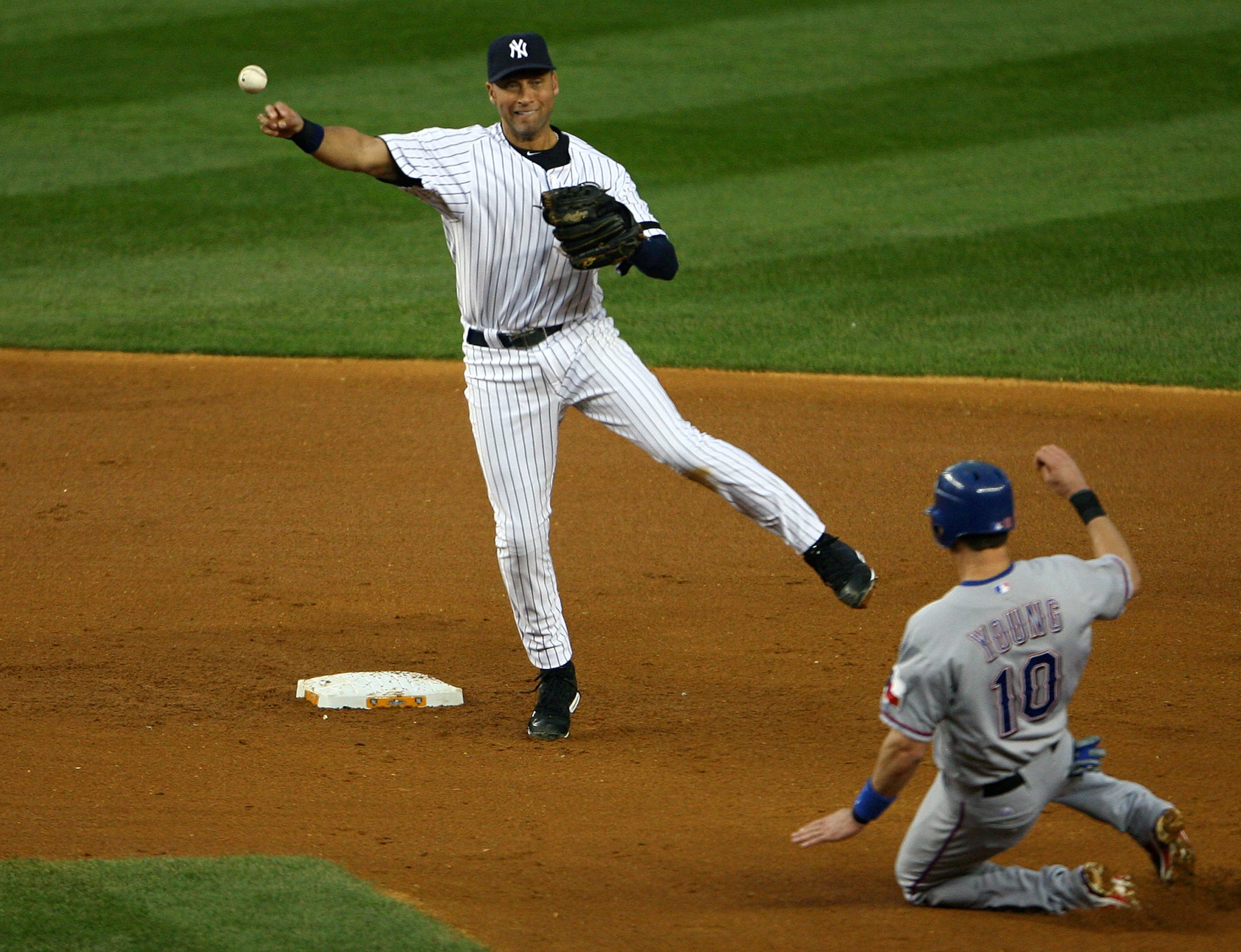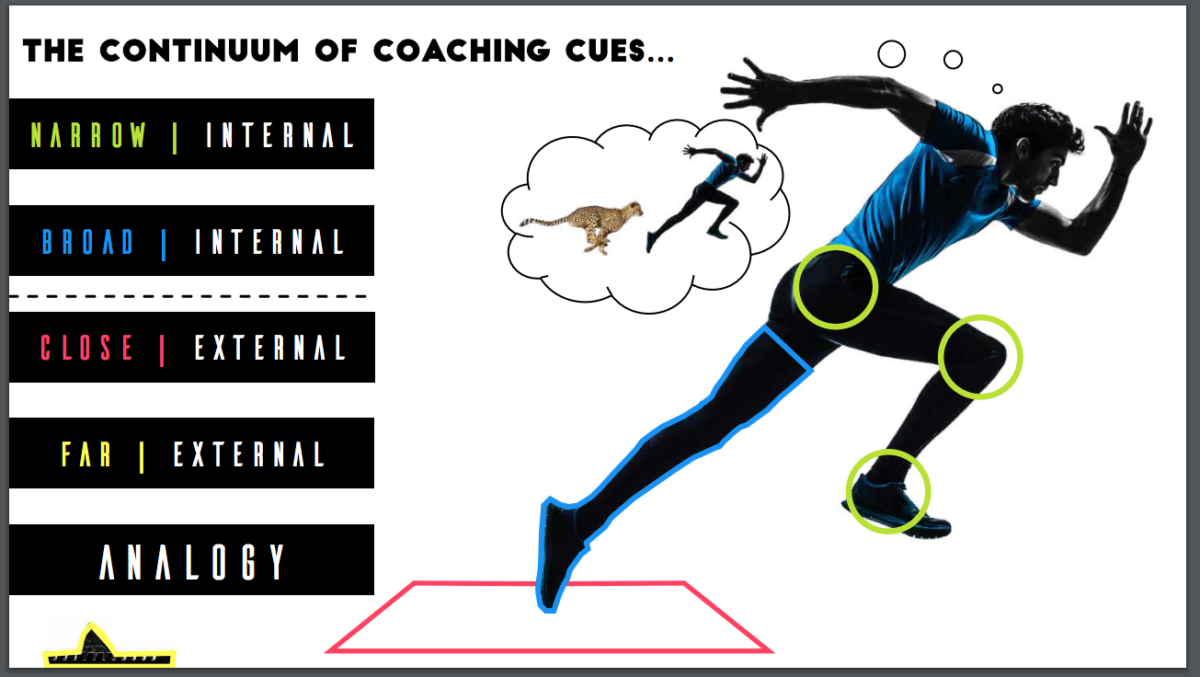Analogies are a powerful form of language all coaches can utilize. They work by combining a specific objective (e.g. rotate better) with a familiar association (e.g. phone booth) in order to create a vivid image for execution (e.g. rotate in a phone booth).
Instead of asking our athletes to:
- Accelerate faster
- Start in an athletic position
- Jump higher
we can ask them to:
- Turn their body into a jet taking off
- Pretend they’re guarding LeBron James
- Turn their legs into pogo sticks
In both examples, we’re asking our athletes to do the same exact thing. However, using analogies gives our athletes a much better picture for how to do it. Turning your body into a jet is going to create the posture and angles required to get your body to overcome inertia. Imagining you’re guarding LeBron James is going to get you into a strong base with your feet outside your shoulders and chest over your toes. Thinking about turning your legs into pogo sticks is going to create stiffness in the lower extremities that is beneficial for creating vertical force.
When we can create a vivid picture in the minds of our athletes, we increase the likelihood that our message will produce a desired movement outcome. There’s no gray area for misinterpretation. Just telling someone to “use their legs more” or “run faster” might address the objective, but it is very vague when it comes to execution. The vaguer it is, the less likely it will be done the way you want.
Analogies, on the other hand, are much more specific. All you need to do is find something that athlete can relate to (other sports, hobbies, video games, etc.). Once you find something, you have the keys to their interest. All that’s left is creatively crafting your message in a way that will best get their attention.
Below are 10 analogies you can use with your baseball athletes at practice.
- Throw around the runner on a double play
Too often coaches take linear solutions to a rotational problem. Cues like “finish your pitch” or “stay on top of the ball” can create linear adaptations that bring the arm inside and out of the plane of rotation. This can create pushy and disconnected arm paths.
Instead, kids need to learn how to get their arms away from them. They’re not throwing darts. They’re throwing baseballs. In order to throw a baseball well, the arm needs to unwind around the body and the hand needs to work away from the midline into release. Giving them the imaginary constraint of an incoming baserunner can help them do just that.

- Don’t fall off the cliff
Humans are primed with instincts for survival. Tapping into them can create some vivid pictures and sensations you can use to your advantage. One of these is the thought of “not falling off the cliff.” This is great for pitchers who don’t have great brakes and continue to fall forward after ball release. Have them pretend they’re landing on the edge of a cliff when they throw. The “consequences” for falling forward after release can teach them how to stop and rotate in a tighter window.
Another thought you can use for this is “don’t get punched in the face.” Have athletes pretend there is a fist right in front of their face when their front foot lands. If they fold forward instead of rotate, they’re going to get punched in the face. This might be a hair of an exaggeration, but the thought can influence a better pattern that’s less linear and more rotational.
- Pitch like you’re throwing a punch

Relating movements from other sports to baseball is a great way to share the same message using a slightly different lens. A popular one we like to refer to is throwing a punch. In order to throw a punch, you have to do a lot things that baseball players also need to do:
- Get into a strong and centered base
- Stay closed with the pelvis and torso into foot plant
- Strike by rotating the torso around a stable lower half
- Brace and decelerate into impact
- Produce a lot of force in a small window
If you’re working on any of the above, using the thought of “throwing your best punch” can be incredibly impactful. We commonly tell pitchers to “throw their punch from deep” to keep them from opening up too soon. Telling a kid to “stay closed longer” addresses the same thing, but the thought of a punch creates a much more specific picture. Better visuals create better adaptations.
- Pretend like you’re hitting a ball that weighs 500 lbs.
This analogy is one of the best ones Eugene has ever come up with. He got the inspiration when he was doing research into martial arts and stumbled on the word “kime.” In Japanese, the word means “focus.” In martial arts, it references the bracing moment you feel right before you deliver a punch. For Bruce Lee to get off his famous one-inch punch, he needed to metaphorically turn his body into a brick wall. It might have looked like he was just punching with one finger, but he was actually using his entire body because of his ability to rapidly brace into impact. This helped him deliver a pretty forceful punch despite having to navigate a small window of time and space.
Sound familiar?
If you’re working with a hitter who’s flying open, peeling off baseballs, lacks stability, and can’t transmit a ton of force into the ball, smack them in the stomach a couple of times and ask them what they feel. They’ll probably respond with something along the lines of “tight” or “braced.” Have them use that sensation when they go to hit the ball. When you do this, you’ve successfully taught someone how to hit the ball like it weighs 500 lbs.
The thought alone of hitting the ball like it weighs 500 lbs. can create an immediate adaptation. You can also try “turn your body into a brick wall at impact” and “try to smash open a watermelon.” If the image still isn’t clear, just have the hitter strike a basketball. What they feel doing that is what they should be doing when they hit a baseball.
If you use any of these thoughts, this is one you need to try out.
- Move forward like someone is on your back
One of the most common energy leaks we see with hitters and pitchers is pushing out of the ground (oddly enough, often caused by trying to use the ground more). A great analogy you can use to counter this is to create the sensation of having someone on your back. If you’re working with a couple of kids, you can have them demo it out and hop on each other’s backs. Ask them what they felt and tell them to take it into their swing. You’ll often see immediate improvements in posture, connection to the ground, and space.
- Crack a whip
The whip analogy can be used in a couple of ways. For one, it can give a really good visual for how the arm should work to transmit force. Former MLB All-Star Ricky Romero talked about how his dad growing up taught him to use his arm like a whip. This helps create sensations for when to create tension as too much too soon eliminates your ability to create the “crack” at the end.
It can also be used to explain the importance of deceleration in applying directional force. To crack a whip, the arm and hand need to come to stop in order to get the whip to go forward. This gets energy out to the tip and creates that cracking sound. If the arm and the hand continue to drag through and never come to a stop, you lose the ability to crack the whip.
- Pitch like you play shortstop
This is a good one if you have a kid that slings it across the diamond and looks like a robot when he toes the rubber. Pitchers are often taught in a way where positions and aesthetics become more important than learning how to move dynamically. When this happens, you’ve “pitchered” a kid: You’ve taken someone who knows how to move well and put him into a box where he can’t move well anymore.
An easy way to get them out of this box is to teach them how to be an athlete again. In other words, give them the freedom to pitch like they play shortstop. Allowing them to do this often creates an immediate impact on their delivery.
This can also work for lefties. Since they probably didn’t play infield or catcher growing, they probably didn’t spend a lot of time making dynamic and athletic throws. This makes it even more important that they do.
- Pretend your front foot just landed in cement
Giving athletes the thought of “sticking” their front foot in cement can create sensations that influence a more stable lower half. The more stable you are down low, the better you can rotate up top. If the front foot is sliding or not accepting force early enough, something in the chain is unstable (e.g. pushy, quad dominant lower half). Using the thought of landing in cement can clean some of this up.
Something similar to this is thinking about the feet as “anchors” or “pegs” in the ground. Energy is created proximally to distally. What’s furthest away from us (e.g. arms, legs) should be controlled by what is most central to us (e.g. pelvis, trunk). Overactive extremities flip this on its head. By killing the feet and thinking of them as anchors/pegs, you give the middle the ability to control the movement and prevent the feet/legs from creating inefficient patterns.
- Rotate in a phone booth
Most players stink at rotating. This is because how rotation is often taught (e.g. get extension, chest to glove) is largely ineffective. Good rotation happens where the trunk and pelvis work around our spine and through a small window of space. Using the thought of “rotating in a phone booth” can help give kids a pretty effective visual for this. A similar thought you can use is “rotate your head around a cement pole.” This gives kids the same visual for how to rotate around their spine without wasting a ton of movement.

- Spread the floor like you’re riding a horse
Eugene picked up on this one in a conversation with Hunter Bledsoe. A great visual for the forward move is to give kids the thought of “straddling a horse.” This can help give them a better feel for how to spread their legs apart, control their center of mass, and keep their nose over their belly button.
BONUS: Player Imitations
A great way to stimulate creativity and athleticism in kids is to have them try and imitate their favorite players. Have them pick out two or three they really like or pick out a couple that have a similar movement profile. This can be a huge unlock for kids who are struggling to feel athletic in the box. We know that kids are great at imitating. Use this to your advantage when you’re trying to teach them something new.
These are only 10 suggestions. The ceiling for the analogies you can create is limitless. The more you use them, the better you’ll be able to communicate with kids.
Don’t just talk to your players. Use analogies and talk to them in color.

